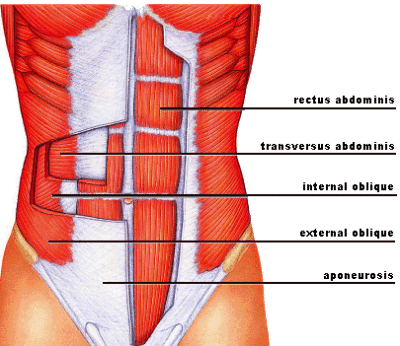For The Love of Your Core — STOP Pulling Your Bellybutton to Spine
Learn how to properly engage your transverse abdominis
Why is the bulk of the fitness industry providing us with incorrect ways on how to correctly connect with our inner core muscles?
The cues most fitness professionals hear are unfortunately “pull your bellybutton to spine” or “scoop your mid-section”. While these cues attempt to help our clients connect with their deepest core muscle, the Transverse Abdominis (TA), they often prevent the muscle from connecting in a functional way. The majority of women I work with experience a light bulb effect when taught a more complete way of activating the core.
It’s as if they are feeling their TA for the first time ever.

As a pre and postnatal professional, having a deeper understanding of this important inner unit muscle is crucial as we help our pre and postnatal clients avoid challenges like diastasis recti and the various aches and pains of pregnancy.
The infamous cues of pulling the bellybutton to spine will only have your clients isolating the front of their TA and shutting off the other abdominal muscles. This can hinder your producing fast results with postpartum clients who need a highly functional TA in order to handle the demands of carrying their newborn (not to mention the clients who want to bounce back quickly). For fastest results, you want them to be connecting with the entire circumference of the TA, obliques, rectus abdominis and pelvic floor.
First, we need to understand what the TA muscle is and what role it plays in regards to the core. The Transverse Abdominis is the body’s innermost abdominal muscle or the body’s natural corset. The muscle attaches on either side of your spine and wraps the entire circumference of your torso. As it moves toward the front of your torso, the TA spans from the top of the pelvis to the bottom of your ribcage. It typically reminds me of not only a corset but also a protective shield and internal column of support for our trunk. This incredible muscle is responsible for protecting and stabilizing the low back and spine along with all of the internal organs. The other “job” of the TA is to teach all of the more external abdominal muscles; the obliques and rectus abdominis to lay flat against the torso and spine. Though pregnancy changes the nature of the mechanics, the TA’s role essentially remains the same.

The simple fact that this muscle wraps the entire circumference of the torso tells us that to be used functionally, we must be teaching it in a functional way. What use is a muscle that cannot fire optimally? It’s crucial for stability, functional movements and esthetics that we rewire our clients brains into being able to “wrap” their TA to deeply connect with it. The Bloom Method’s techniques can help your clients connect correctly with this muscle by using diaphragmatic breathing and conscious exhales so that the brain responds quickly to the new found connection.
Practice on yourself for a moment. Relax your torso by either lying supine or sitting comfortably in a flat-bottomed chair. If lying make sure to keep a natural curve in your spine as your emerging practice of using the TA may sometimes pull your low back to the floor. This is much different from “tucking” the pelvis to press the lower back into the floor. This “tucking” movement can often times shut off the TA or create a false understanding of using it during the exercise. If sitting, make sure that the ribcage stacks on top of the pelvis and the shoulders on top of rib cage.
Take a deep diaphragmatic inhale, filling your belly with a deep breath that expands your entire abdomen. Follow with a slow, yet deep exhale, making a powerful sssssss sound as you exhale and wrap the TA from either side of your spine around your entire torso. This may be a new sensation and way to connect to your deep core so here are a few unique ways to help you connect to this movement.As you exhale imagine drawing your hipbones in towards one another as if to kiss one another. You can also imagine that your exhale attempts to draw your obliques to the front of your torso, near your belly button.Knitting the bottom of your ribcage together is a super common cue that helps connect to the upper portion of the TA.
Connecting with each of these cues over time will help you to connect to each section of the TA while ultimately helping the entire musculature fire together. Exhaling with this type of focus will more readily turn on your client’s rectus abdominis, obliques, pelvic floor and multifidus musculature in a functional manner. Correctly activating the TA isn’t about isolating the muscle at all, in the end it’s about correctly activating the entire core musculature. This simple technique creates a super easy and functional way to connect with the inner core unit and should be the first step to every core-related exercise. Once your clients tap into their inner core, they should learn to use this engagement during the work portion of every abdominal exercise.
The common “belly button to spine” cue needs to be a thing of the past and everyone exercising their core needs to be educated around this. I’m extremely confused as to how our fitness experts and physical therapists have allowed core connection to evolve in this way, knowing how the TA attaches and lies along the torso. My assumption is that it was an attempt to get everyone on the same page with core activation yet it’s as if there was no thought put into how the muscle works and moves within our bodies. Have you ever felt your obliques or back of the transverse turn on while “pulling bellybutton to spine”? The “aha!” moment felt by my clients when they feel the wrap for the first time really lets them feel the difference compared to what they were previously doing at the gym (often under the guidance of a personal trainer). This is a simple technique that our clients deserve to be using in their exercise routines. This is one of the reasons why clients of The Bloom Method bounce back quicker, never experience back pain, and rarely get diastasis recti. Understanding correct and functional usage of the TA has also proved to be extraordinarily helpful during the pushing phase of birth.Next time you coach your pre or postnatal client on doing ab exercises, whether it’s on the gym floor or in a group class, try using cues that have her tap into her inner core unit more deeply by wrapping the Transverse Abdominis, rather than just pulling bellybutton to spine.



